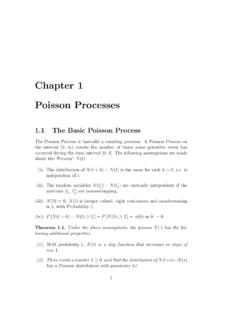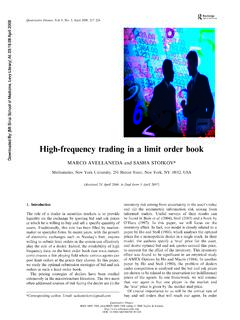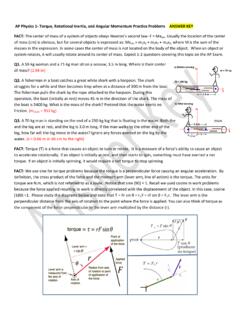Transcription of Lecture 11 { Spin, orbital, and total angular momentum 1 ...
1 Lecture 11 Spin, orbital, and total angular Mechanics1 Very brief backgroundIn 1922, a famous experiment conducted by Otto Stern and Walther Gerlach, involving particles subject to anonuniform magnetic field, identified two surprising properties of the angular momentum : 1) the componentsof the angular momentum are quantized, they can only take certain discrete values; 2) there exists atype of angular momentum that is intrinsic to a particle, even a point particle, and that cannot be put inthe formr p: this is the so-called spin angular momentum . The total angular momentumJis the sumof the orbital angular momentumLand the spin angular momentumS:J=L+S.
2 In this Lecture , we willstart from standard postulates for the angular momenta to derive the key characteristics highlighted by theStern-Gerlach General properties of angular momentum Commutation relations between angular momentum operatorsLet us first consider the orbital angular momentumLof a particle with positionrand momentump. Inclassical mechanics,Lis given byL=r pso by the correspondence principle, the associated operator is L=~ir The operator for each components of the orbital angular momentum thus are Lx= y pz z py=~i(y z z y) Ly= z px x pz=~i(z x x z) Lz= x py y px=~i(x y y x)We also define the operator L2= L2x+ L2y+ L2zLet us start with the commutation relation between Lxand Ly.
3 [ Lx, Ly] = [ y pz z py, z px xpz] = ( y pz z py)( z px xpz) ( z px xpz)( y pz z py)= [ y pz, z px] [ z py, z px] [ y pz, x pz] + [ z py, x pz]= [ y pz, z px] + [ z py, x pz] = y pz[ pz, z] + x py[ z, pz]Now, we know that [ z, pz] =i~, so we conclude that[ Lx, Ly] =i~( x py y px) =i~ LzBy cyclical permutations one easily obtain the other relations:[ Ly, Lz] =i~ Lx[ Lz, Lx] =i~ LyWe note a very important results: the three components of the orbital angular momentum are notcompatible with one another, and have associated uncertainty operator L2, on the other hand, commutes with Lx, Lyand Lz. Indeed,[ L2, Lz] = [ L2x, Lz] + [ L2y, Lz]and[ L2x, Lz] = Lx Lx Lz Lz Lx Lx= Lx Lz Lx i~ Lx Ly Lx Lz Lx i~ Ly Lx= i~( Lx Ly+ Ly Lx)1 Repeating the same calculation for [ L2y, Lz], we would find[ L2y, Lz] =i~( Lx Ly+ Ly Lx)so that finally[ L2, Lz] = 0and in exactly the same way, we would prove[ L2, Lx] = 0[ L2, Ly] = 0A postulate of quantum mechanics is that all types of angular momentum operator J, orbital or Spin, satisfy the following commutation relations.
4 [ J2, Jx] = 0[ J2, Jy] = 0[ J2, Jz] = 0(1)[ Jx, Jy] =i~ Jz[ Jy, Jz] =i~ Jx[ Jz, Jx] =i~ Jy(2)We will now take this relations as a starting point, and derive general properties of any angular momentumoperator Jthat satisfies these Eigenvalues of the operators J2and JzWe take the commutation relations given by Eq. (1) and Eq. (2) as our postulate, and show that alone theyallow us to prove that the eigenvalues or J2and Jzare quantized. Since J2and Jzcommute, there existsa basis of eigenvectors that are common to these two operators. Let us call|a,b an eigenstate of both J2,with eigenvalue~2a, and of Jz, with eigenvalue~b. The factors~2and~appear because we have normalizedthe eigenvalues so thataandbare dimensionless numbers.
5 We thus have J2|a,b =~2a|a,b Jz|a,b =~b|a,b We also have the additional normalization condition a,b|a,b = 1 Let us now construct the operators J+= Jx+i Jy J = Jx i JyNote that J+and J are not Hermitian, but Hermitian conjugates of one another: ( J+) = J . We willnow see what happens when one applies J+ and J to the state|a,b .Since J2commutes with Jxand Jy, we can write J2( J |a,b )= J ( J2|a,b )= J (~2a|a,b )=~2a J |a,b where J stands for either J+or J . We see that J |a,b is an eigenvector of J2with eigenvalue~ , using the commutation relations[ Jz, J+] = [ Jz, Jx+i Jy] =i~ Jy+i( i~) Jx=~ J+we find Jz J+|a,b = J+ Jz|a,b +~ J+|a,b =~(b+ 1)|a,b Following the same procedure, we could also show that Jz J |a,b =~(b 1)|a,b We see that J+|a,b is an eigenvector of Jzwith eigenvalue~(b+ 1), and J |a,b is an eigenvector of Jzwitheigenvalue~(b 1).
6 For these reasons, J+and J are sometimes calledladder just showed that J+|a,b is colinear with the normalized eigenstate|a,b+ 1 , and that J |a,b iscolinear with the normalized eigenstate|a,b 1 . There exist complex numbersc+andc such that J+|a,b =c+|a,b+ 1 J |a,b =c |a,b 1 Since J is the Hermitian conjugate of J+, the square of the norm of the ket of J+|a,b is|c+|2=( a,b| J )( J+|a,b )= a,b| J J+|a,b We can easily compute J J+= J2x+i[ Jx, Jy]+ J2y= J2 J2z ~ JzThus|c+|2=~2[a b(b+ 1)]In the same way, you can convince yourself that|c |2=~2[a b(b 1)]Since|c+|2and|c |2are positive quantities, we have restrictions on the allowable values for the eigenvaluesaandb.
7 Indeed, if for a given value ofa, any value ofbwould be allowed, then by applying J+or J to|a,b multiple times, we would keep increasing the productsb(b+ 1) until|c+|2becomes negative. The only wayto avoid this contradiction is by saying thatbmust be restricted to a finite interval. Indeed, the only way ofstopping the iterative process is to find|c+|= 0 andc |= 0 at some point. There must therefore exist:1. A maximum valuebmaxofbsuch thata=bmax(bmax+ 1)2. A minimum valuebminofbsuch thata=bmin(bmin 1)The ket J+|a,bmax then is 0, as is the ket J |a,bmin . We can writebmax(bmax+ 1) =bmin(bmin 1)The only solution of this equation withbmax> bminisbmax= bmin>0.
8 And since one can go from theeigenvaluebmintobmaxby steps of size 1 through the iterative application of J+, we have the additionalconditionbmax=bmin+kwherek N, we conclude:bmax=k2= bmink NLet us definej k/2, wherejis either an integer or a half-integer. We then havea=j(j+ 1), andbcanvary from jtojin steps of size 1. We can summarize this as the following important result: The eigenvalues of J2are of the form~2j(j+ 1) withjpositive integer or half integer For a fixedj, the eigenvalues of Jzcan be written in the form~m, wheremcan take the following(2j+ 1) values: j, j+ 1, j+ 2,..,j 2,j 1,j Ifjis an integer, there is an odd number of eigenvalues of Jzfor thatj Ifjis a half-integer, there is an even number of eigenvalues of Jzfor thatjNote that the eigenstates of J2with eigenvalue~2j(j+ 1) belong to a subspace of dimension at least2j+ 1.
9 Indeed, we just found 2j+ 1 of them that were also eigenstates of Jzwith distinct eigenvalues; theyare therefore order to motivate the next section, let us talk some more about the Stern-Gerlach experiment. It foundthat angular momentum was quantized, which can be seen as a consequence of the commutation relations(1) and (2). At this point, it could still be the case that angular momentum only consists ofL, the orbitalangular momentum , since Ldoes satisfy (1) and (2). However, the Stern-Gerlach found a second importantproperty of angular momentum : it can be such thatjis half-integer. We will now show that this impossibleif the angular momentum is only made ofL, for reasons that have not yet been Orbital angular Orbital angular momentum in spherical coordinatesWe use here the usual spherical coordinate system ( , , ), with associated basis vectorse ,e , ande ,where is the colatitude and the azimuth.
10 In these coordinates, the orbital angular momentum operatoris L= e ~i =~i(e e sin )The Cartesian components of Lare Lx=~i( sin cot cos ) Ly=~i(cos cot sin ) Lz=~i For the sake of completeness, one may also calculate the expression for L2. This is most convenientlydone by applying L2to an arbitrary function (r): L2 = ~2(e e sin )(e e sin )= ~2[e (e ) e (e sin ) e sin (e )+e sin (e sin )]Now, since e / = e , e / =e cos , e / = 0, e / = (e sin +e cos ), this becomes L2 = ~2( 2 2+ cot +1sin2 2 2)In other words, L2= ~2( 2 2+ cot +1sin2 2 2)(3)Lastly, it can be convenient to use the variableu cos instead of.














